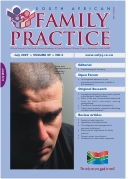Prevalence of Anaemia in Pregnancy at Uthungulu Health district of KwaZulu-Natal, South Africa - 2003.
Keywords:
Anaemia, Pregnant mothers, Prevalence, Booking visit for antenatal care.
Abstract
Background An estimated 30% of the world’s population is affected with anaemia. Anaemia in pregnancy is a leading cause of maternal and perinatal deaths in developing countries. In developing countries, anaemia affects almost two thirds of the pregnant population. It is also estimated that anaemia is responsible for as much as 20% of all maternal deaths in Sub-Saharan Africa. Maternal anaemia is a risk factor for infant iron deficiency anaemia and, if left uncorrected, can be associated with adverse behavioural and cognitive development in children. The prevalence of anaemia in pregnancy is estimated at between 35% and 75% in sub-Saharan Africa. However, the area-specific health problems during pregnancy are not known. In order to improve maternal health and the health of the foetus during pregnancy, knowledge of the prevalence or incidence of pregnancy-related conditions would be useful for district management teams, as well as for provincial and national maternal, child and women’s health programme development. The objectives of this study were to describe haemoglobin levels and estimate the prevalence of anaemia among pregnant women at their booking visit. Methods A retrospective cross-sectional descriptive study was conducted using the antenatal clinic registers of primary healthcare (PHC) clinics in the Empangeni subdistrict of the Uthungulu Health District from July to December 2003. Data were gathered from 1 214 consecutive pregnant women who attended for antenatal care at three randomly selected primary healthcare clinics during the study period. We examined the distribution of Hb values to determine the percentages of women with anaemia (Hb < 10 gm/dL) and severe anaemia (Hb < 7 gm/dL), and compared this with the prevalence of anaemia according to the WHO definition (Hb < 11 gm/dL). Results In terms of the South African National Department of Health definition of anaemia in pregnancy, (haemoglobin < 10 gm/dL), 30.1% of the attendees were anaemic. According to the World Health Organisation (WHO) criteria (Hb < 11 gm/dL), the prevalence of anaemia was 57.3%. The difference in the prevalence of anaemia on the basis of the two different criteria was significant (p = 0.000). This finding was comparable to studies conducted in other Sub-Saharan African countries. Conclusion The prevalence of anaemia in pregnancy in this community is high. The prevalence of anaemia varied greatly when the WHO definition was used. The pregnant women of this community attend the healthcare facility very late for their booking visit, in spite of free maternity services at public health facilities. There is an urgent need for health education and health promotion programmes in this population for early booking for antenatal care. Further investigations are needed to establish the risk factors for, causes of and preventive interventions for anaemia in pregnancy.
Published
2007-07-04
Issue
Section
Original Research
By submitting manuscripts to SAFP, authors of original articles are assigning copyright to the South African Academy of Family Physicians. Copyright of review articles are assigned to the Publisher, Medpharm Publications (Pty) Ltd, unless otherwise specified. Authors may use their own work after publication without written permission, provided they acknowledge the original source. Individuals and academic institutions may freely copy and distribute articles published in SAFP for educational and research purposes without obtaining permission.

